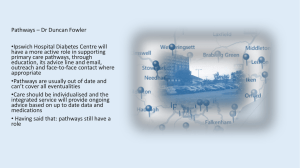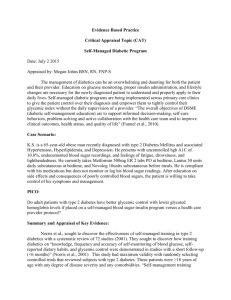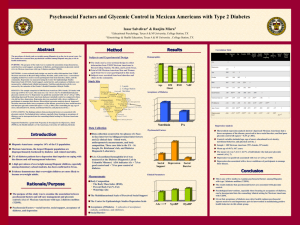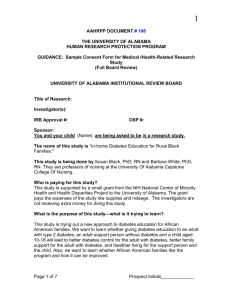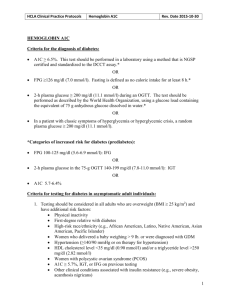2010update - New Mexico Health Care Takes on Diabetes
advertisement
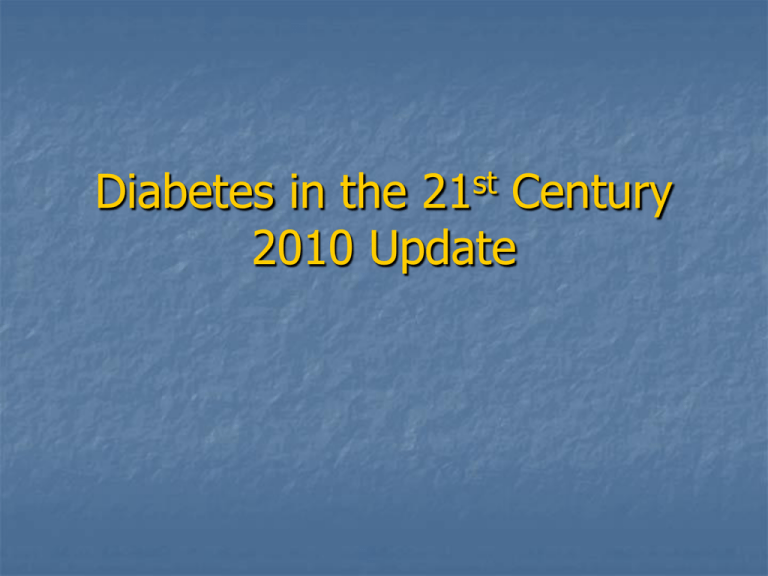
Diabetes in the 21st Century 2010 Update American Diabetes Association 2010 Guidelines – Diagnostic Criteria A1C > or = 6.5% is included as diagnostic criteria for diabetes. A1C = 5.7- 6.4 – at increased risk for diabetes Must be done by a lab method with appropriate certification and standardization. Point of care testing does not qualify. American Diabetes Association 2010 Guidelines – Treatment Goals A1C < 7% in general, non-pregnant adult population. In select persons may target closer to normal - if can be achieved without significant risk of hypoglycemia or adverse events (i.e.: persons with diagnosis of short duration, long life expectancy, no history of CVD) American Diabetes Association 2010 Guidelines – Treatment Goals Conversely, less stringent goals may be appropriate for patients with history of hypoglycemia, limited life expectancy, advanced complications, extensive comorbidities or difficult to control despite multiple modalities. American Diabetes Association 2010 Guidelines – Dietary Guidelines ADA comments that the use of glycemic index and glycemic load may add modest benefit for glycemic control over consideration of total carbohydrate alone. Optimal mix of macronutrients remains unclear. Several studies have demonstrated some benefits of short term use of low carbohydrate diets (<130 Gm/day) with weight loss, improved HDL and triglycerides, or improved A1C, however long term metabolic effects remain unclear and monitoring is warranted. American Diabetes Association 2010 Guidelines – Dietary Guidelines Continued support of limiting intake of saturated fats to less than 7% total caloric intake and minimizing trans fats Total caloric intake must be appropriate for the weight management goal American Diabetes Association 2010 Guidelines - Exercise 150 min per week of moderate intensity (or 75 min vigorous intensity) In absence of contraindications, adding resistance training 3 times a week has been shown to reduce insulin resistance Medication Update Avandia remains in limelight. Controversy regarding evidence of increased risk of cardiovascular morbidity and mortality. Are the risks greater than the benefits? As of September 2010, FDA has determined to allow to remain on market with significant restrictions Patients should be advised not to stop Avandia without consulting with their diabetes health care provider, but to discuss treatment changes as appropriate. TZDs as a class are also noted to increase bone loss and risk of fracture. Medication Update Liraglutide (Victoza) – GLP1 receptor agonist Similar effects, side effects and cautions as exenatide (Byetta) Once a day subcutaneous dosing (start with 0.6 mg/day, increase to 1.2 mg/day after 1 week, can titrate up to 1.8 mg/day). Can be dosed at any time of day Medication Update GLP1 receptor agonists noted to have a risk of pancreatitis – screen for history of pancreatitis, gallstones, alcohol abuse or hypertriglyceridemia as contraindications. Byetta has had post marketing reports of acute renal insufficiency and renal failure. Monitor kidney function at initiation and with dose increases. Medication Update New DPP4 inhibitor Saxagliptin (Onglyza) Effects, side effects and cautions similar to sitagliptin (Januvia) Dosing 2.5 – 5 mg PO QD Resources: NMTOD Diabetes Compendium http://nmtod.com/diabetesresources.html American Diabetes Association (2010). Standards of medical care in diabetes – 2010. Diabetes Care, 33, s11-s61. Retrieved August 17, 2010 from http://care.diabetesjournals.org/content/33/Sup plement_1/S11.full.pdf+html.





